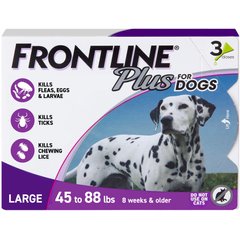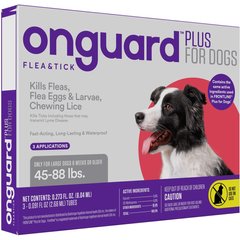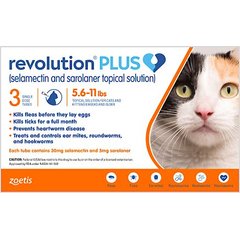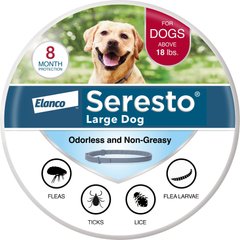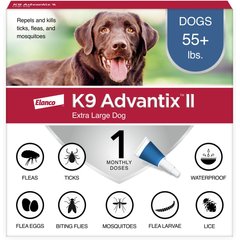How Do Common Tick Medications Work on Pets?
There are a few things to think about when you are looking to start your dog or cat on flea and tick prevention medication. First, not all flea preventions are effective against ticks.
Dogs and cats process medications differently, so it's important that only medications labeled for your feline friends are used on cats.
Why Is Tick Prevention Important for Pets?
Ticks are most commonly found in the eastern United States and the West Coast, although they can be found throughout the country.
Ticks are hardy creatures that can harm our pets from their bites alone, and their bites can also contain harmful bacteria that can cause serious disease in our pets.
These illnesses are classified as tick-borne diseases and can cause a variety of illnesses in your pets.
Common illnesses include:
The symptoms of these diseases can vary greatly, but the most common symptoms include fever, swollen lymph nodes, joint pain or swelling, lethargy, and changes in the blood.
Tick-borne diseases can also be transmitted to humans through tick bites. Keeping ticks out of the home through proper tick preventatives can help to keep all the two- and four-legged members of your family safe.
Ticks can cause harm and transmit disease to our furry loved ones, so choosing the right tick prevention is important. Most tick preventions work by disrupting the nervous system of the tick, which leads to eventual death.
How Do Tick Medications Work?
Most of these medications work by disrupting the nervous system of the tick and eventually killing it. This does not necessarily cause the tick to fall off the pet, but it will prevent the tick from completing its blood meal. Tick prevention that works quickly will help to prevent disease transmission.
Many flea and tick preventatives require a prescription, so vets can make sure your pet is getting the right medication and dosage. While some over-the-counter pet flea and tick treatment products work well, tell your pet’s providers what you use so they can ensure it is an appropriate choice based on tick activity in your area. Common ingredients for tick medications include:
-
Fipronil/S-methoprene: Fipronil is a common ingredient in over-the-counter flea and tick preventions. Fipronil kills insects by disrupting the function of their nervous systems.
-
Many products on the market utilize this, including Frontline® Gold/Plus, Effipro Plus, Onguard™ Plus, Catego® (for cats only). These products generally are labeled to clear ticks in 24-48 hours.
-
Many products for dogs that are in this category also contain pyrethrins, which are toxic to cats. It is important that only cat-approved products are used for cats.
-
-
Isoxazoline: Isoxazoline is a newer, highly effective prescription preventative that is effective against fleas and several types of ticks. It works effectively to remove ticks in the first 4-24 hours. This medication type inhibits a neurotransmitter called GABA (gamma-aminobutyric acid) by blocking a channel that is found in insects. This leads to the tick or flea becoming paralyzed before it dies.
-
Bravecto® and Credelio™ both have formulations designed specifically for our feline and canine family members.
-
Simparica™ and NexGard® are solely for dogs.
-
Revolution® Plus is currently available only for cats.
Imidacloprid/permethrin: These ingredients are the mainstay of the Advantage line of products, which includes Advantix™ (over the counter for dogs) and Advantage™ Multi (prescription-only for dogs).
-
This class of medication is for dogs only, and is derived from the chrysanthemum plant, targets the tick’s nervous system, causing rapid nerve firing that results in death.
-
-
Imidacloprid/flumethrin: These ingredients are found in the long-lasting, over-the-counter Seresto® collar.
-
This collar lasts for up to eight months and usually works to kill ticks in the first 24-48 hours. This synthetic medication combination targets the tick’s nervous system, causing rapid nerve firing resulting in death.
-
Seresto collars are best ordered from your veterinarian or trusted pet supply store, as counterfeit products have been seen on the market.
-
-
Do Tick Medications Work Differently for Cats and Dogs?
Medications for flea and tick prevention for dogs and cats work in generally the same way, by disrupting the tick’s nervous system function, leading to death. Some of these medications are not safe or approved for use in cats. Cats have much more sensitive systems when it comes to certain medications.
For felines, it is important to use only products that are labeled for use in cats; using products that contain permethrins can cause toxicity and even death in cats.
Can Pets Still Get Ticks Even on Tick Medication?
Tick preventatives can kill ticks, but it is still important to check your pets diligently, especially in tick-endemic areas of the nation.
Ticks are hardy to the point that they can survive in temperatures lower than 14 degrees and higher than 90 degrees Fahrenheit.
The longer a tick is attached to your pet, the more susceptible the pets is to getting a tick-borne disease. Lyme disease can take 24-48 hours to spread, but the disease-causing bacteria of Ehrlichiosis and Rocky Mountain spotted fever can be transmitted in as little as three to six hours.
Veterinarians recommend that you check your pet after walking in tall-grass or woodsy areas, and to remove or have a veterinary professional remove any ticks found.
Work with your veterinarian to see if Lyme vaccination and yearly testing for tick-borne diseases would be right for your dog.
Vaccination for Lyme disease is not available for cats, and testing for Lyme disease is not routinely done by veterinarians. That makes tick prevention for your cat even more essential.
Featured Image: Chalabal/iStock / Getty Images Plus via Getty Images


